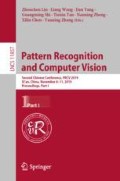Abstract
Functional magnetic resonance imaging (fMRI) plays a significant role in the study and analysis of brain cognitive function. In the existing fMRI classification research, because of the small number of trainable samples, it is easily over-fitted in the classification task. In this paper, we propose an improved deep learning generative adversarial network (GAN) to augment fMRI functional connectivity data. The network has the data augmentation ability using Wasserstein distance and double-class distance constraint to augment the data of subjects and control groups. Finally, the data generated by the GAN are used to improve the ability of the classifier. We investigated two brain disorders, attention deficit hyperactivity disorder (ADHD) and autism spectrum disorder (ASD), and evaluated the classification performance of the model in these two diseases. The results revealed that compared to existing classifiers, classification accuracy was greatly improved after data augmentation by the GAN. In addition, compared to several common deep network data generation methods, the performance of the proposed network is significantly better.
Access this chapter
Tax calculation will be finalised at checkout
Purchases are for personal use only
References
Abraham, A., et al.: Deriving reproducible biomarkers from multi-site restingstate data: an autism-based example. NeuroImage 147, 736–745 (2017)
Arjovsky, M., Bottou, L.: Towards principled methods for training generative adversarial networks, 1050 (2017)
Baumgartner, C.F., Koch, L.M., Can Tezcan, K., Xi Ang, J., Konukoglu, E.: Visual feature attribution using Wasserstein GANs. In: Proceedings of the IEEE COnference on Computer Vision and Pattern Recognition, pp. 8309–8319 (2018)
Bishop, C.M.: Training with noise is equivalent to Tikhonov regularization. Neural Comput. 7(1), 108–116 (1995)
Biswal, B., Zerrin Yetkin, F., Haughton, V.M., Hyde, J.S.: Functional connectivity in the motor cortex of resting human brain using echo-planar MRI. Magn. Reson. Med. 34(4), 537–541 (1995)
Costa, P., Galdran, A., Meyer, M.I., Abramoff, M.D., Campilho, A.: Towards adversarial retinal image synthesis. IEEE Trans. Med. Imaging 1 (2017)
Ge, W.: A perspective on deep imaging. IEEE Access 4(99), 8914–8924 (2017)
Goodfellow, I.J., et al.: Generative adversarial nets. In: International Conference on Neural Information Processing Systems (2014)
Biomarkers Definitions Working Group, Atkinson Jr, A.J., Colburn, W.A., DeGruttola, V.G., DeMets, D.L., Downing, G., et al.: Biomarkers and surrogate endpoints: preferred definitions and conceptual framework. Clin. Pharmacol. Ther. 69(3), 89–95 (2001)
Gulrajani, I., Ahmed, F., Arjovsky, M., Dumoulin, V., Courville, A.: Improved training of Wasserstein GANs (2017)
Heinsfeld, A.S., Franco, A.R., Craddock, R.C., Buchweitz, A., Meneguzzi, F.: Identification of autism spectrum disorder using deep learning and the abide dataset. Neuroimage Clin. 17(C), 16–23 (2018)
Kingma, D.P., Welling, M.: Auto-encoding variational bayes (2013). arXiv preprint arXiv:1312.6114
Koyamada, S., Shikauchi, Y., Nakae, K., Koyama, M., Ishii, S.: Deep learning of fMRI big data: a novel approach to subject-transfer decoding. Computer Science (2015)
Li, F., Tran, L., Thung, K.-H., Ji, S., Shen, D., Li, J.: A robust deep model for improved classification of AD/MCI patients. IEEE J. Biomed. Health Inform. 19(5), 1610–1616 (2015)
Lin, Z., Yang, C., Zhu, Y., Duchi, J., Fu, Y., Wang, Y.: Simultaneous dimension reduction and adjustment for confounding variation. Proc. Nat. Acad. Sci. U.S.A. 113(51), 14662–14667 (2016)
Mahapatra, D., Bozorgtabar, B., Hewavitharanage, S., Garnavi, R.: Image super resolution using generative adversarial networks and local saliency maps for retinal image analysis. In: International Conference on Medical Image Computing and Computer-assisted Intervention, pp. 382–390 (2017)
Nie, D., et al.: Medical image synthesis with context-aware generative adversarial networks. In: International Conference on Medical Image Computing and Computer-Assisted Intervention (2017)
Plis, S.M., et al.: Deep learning for neuroimaging: a validation study. Front. Neurosci. 8(8), 229 (2014)
Salvatore, C., Cerasa, A., Battista, P., Gilardi, M.C., Quattrone, A., Castiglioni, I.: Magnetic resonance imaging biomarkers for the early diagnosis of Alzheimer’s disease: a machine learning approach. Front. Neurosci. 9, 307 (2015)
Santos, J.S., Savii, R.M., Ide, J.S., Li, C.-S.R., Quiles, M.G., Basgalupp, M.P.: Classification of cocaine dependents from fMRI data using cluster-based stratification and deep learning. In: International Conference on Computational Science and Its Applications, pp. 298–313 (2017)
Schlegl, T., Seebck, P., Waldstein, S.M., Schmidt-Erfurth, U., Langs, G.: Unsupervised anomaly detection with generative adversarial networks to guide marker discovery (2017)
Sejnowski, T.J., Churchland, P.S., Anthony, J., Movshon, J.A.: Putting big data to good use in neuroscience. Nat. Neurosci. 17(11), 1440–1441 (2014)
Song, Y., Epalle, T.M., Lu, H.: Characterizing and predicting autism spectrum disorder by performing resting-state functional network community pattern analysis. Front. Hum. Neurosci. 13, 203 (2019)
Suk, H.-I., Wee, C.-Y., Lee, S.-W., Shen, D.: State-space model with deep learning for functional dynamics estimation in resting-state fMRI. NeuroImage 129, 292–307 (2016)
Vergun, S., et al.: Classification and extraction of resting state networks using healthy and epilepsy fMRI data. Front. Neurosci. 10, 440 (2016)
Wang, G., Kalra, M., Orton, C.G.: Machine learning will transform radiology significantly within the next 5 years. Med. Phys. 44(6), 2041–2044 (2017)
Zhang, Y., Yang, L., Chen, J., Fredericksen, M., Hughes, D.P., Chen, D.Z.: Deep adversarial networks for biomedical image segmentation utilizing unannotated images. In: International Conference on Medical Image Computing and Computer Assisted Intervention, pp. 408–416 (2017)
Zhao, X., Rangaprakash, D., Denney Jr., T.S., Katz, J.S., Dretsch, M.N., Deshpande, G.: Identifying neuropsychiatric disorders using unsupervised clustering methods: data and code. Data Brief 22, 570–573 (2019)
Acknowledgments
This study was supported by the Postgraduate Research & Practice Innovation Program of Jiangsu Province (Project No. SJCX18_0741). Scientific Research Foundation for Advanced Talents of Jiangsu University (Project No. 14JDG040).
Author information
Authors and Affiliations
Corresponding author
Editor information
Editors and Affiliations
Rights and permissions
Copyright information
© 2019 Springer Nature Switzerland AG
About this paper
Cite this paper
Yao, Q., Lu, H. (2019). Brain Functional Connectivity Augmentation Method for Mental Disease Classification with Generative Adversarial Network. In: Lin, Z., et al. Pattern Recognition and Computer Vision. PRCV 2019. Lecture Notes in Computer Science(), vol 11857. Springer, Cham. https://doi.org/10.1007/978-3-030-31654-9_38
Download citation
DOI: https://doi.org/10.1007/978-3-030-31654-9_38
Published:
Publisher Name: Springer, Cham
Print ISBN: 978-3-030-31653-2
Online ISBN: 978-3-030-31654-9
eBook Packages: Computer ScienceComputer Science (R0)

